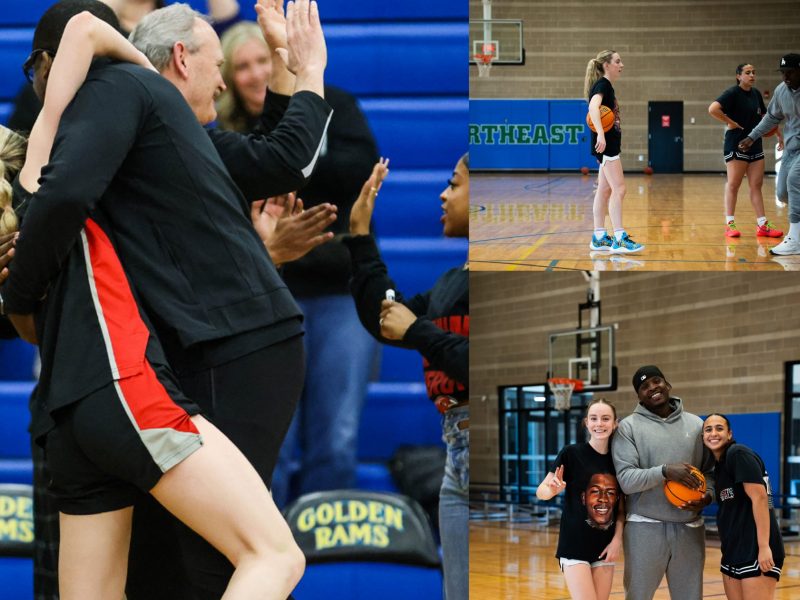According to the odds, Petra Anderson shouldn’t be alive right now.
She had a greater chance of surviving a shark attack or a lightning strike than she did surviving a gunshot wound to the head. Nationally, only 5 percent of those who suffer such an injury live to tell the tale, and Anderson, who had been planning to attend this university’s graduate music school in the fall, is fortunate enough to be one of them.
The night of July 19, the 22-year-old decided to purchase tickets to The Dark Knight Rises on a whim. She wasn’t a huge fan, but she enjoyed the movies and thought it would be fun to see the midnight premiere.
She had just finished studying music composition at the University of the Pacific’s Conservatory of Music and was aspiring to become a professor of music.
Life was looking good for Anderson, and she was looking forward to new horizons.
It should have been a normal night.
There wasn’t anything different about that trip to the movies in a quiet suburb outside of Denver. But after a gunman entered the theater and went on a shooting rampage, leaving 12 dead and 58 wounded, Anderson wound up lying on an operating table at the Aurora Medical Center.
It was something out of a Batman movie: As Anderson, the two friends she came with and the other moviegoers were settling into their seats and watching the opening scenes, a canister flew across the theater and erupted into a thick cloud of smoky gas. Through the haze and panic, a man in a gas mask appeared at the helm and unleashed a hurricane of bullets, pellets and casings upon the audience.
“[Petra], in the hospital, said that, ‘Batman came off the screen and started shooting people,'” Chloe Anderson, her sister, said. “We asked her if it was the real Batman, and after thinking, she said, ‘No. I think it was a fake Batman.'”
That man was allegedly James Holmes, a 24-year-old former graduate student at the University of Colorado living near the theater. Police later said he told them he was the Joker, the most recognizable of Batman’s foes in the series. Between his arrest and the formal filing of charges Monday, new information would come that would paint a chilling picture of Holmes as a villain in his own right.
The Century Aurora 16 shooting, however, was not only one that hit closer to home, but also one that brought to life the seediest parts of a story that has been cherished since Batman’s inception in 1939.
While her sister was out at the movies, Chloe Anderson had stayed home for a quiet night in, only to wake up to the alarming news of a movie villain come to life.
“My mother woke me about an hour after I fell asleep and said, ‘There has been an incident and they say that we need to go get your sister at the hospital,'” Anderson said. “I asked what happened, and my mother said, ‘Well, they said she’s breathing.’ “
“It was all very much a blur,” she added. “I’m not sure there was a moment when it finally sunk in.”
One of Petra Anderson’s friends was hit, and her other friend pulled Anderson down to the sticky theater floor before calling 911 and helping her out of the theater. She suffered three gunshot wounds to her arm as well as a shot to her head; a shotgun pellet traveled through her nasal cavity and brain before becoming embedded in her skull.
For Petra Anderson, what happened next was so unexpected, so rare, even her doctors had the word “miraculous” on the tips of their tongues. In 95 percent of cases where an individual is shot in the head, the victim dies. And for those who do survive, brain damage is almost certain. The news had been unbelievable to her family.
But Anderson was born with a very particular birth defect. There was a channel of fluid that ran through her brain. It wasn’t life threatening – she likely wouldn’t have even known she had it, but for the pellet that shot through the inside of her head. The pellet traveled at such a trajectory that it entered the channel and followed the course of the tunnel, all the way to the back of her head.
Doctors only discovered it when they rushed her into the operating room to remove the pellet. By traveling through the channel, it completely avoided passing through all the vital areas of the brain. Doctors are still waiting to see what kind of damage was done, but they are optimistic there will be little, if any at all.
“I’m also really glad that there is still help,” Chloe Anderson said. “This battle we’re facing is going to take months, long after all the hype is gone. We’re so glad that there are people still willing to come along side us and be with us in this fight. We’re writing the end of this story together.”
Petra Anderson’s recovery is going to be a long one. She will have to put off her plans to become a professor for now, but music, just as it has been a key part of her life and a key part of her identity, has continued to play a key role in her recovery.
On July 25, Petra Anderson asked her boyfriend and fellow musician, Austin Hogan, if he had brought his clarinet to the hospital.
Used to playing in front of large audiences as a clarinet performer, Hogan was playing this time for an audience of one, but it meant so much more, he wrote on the family’s fundraising site.
The music is helping Anderson’s mother to recover as well. The future holds a great deal of uncertainty for a family so united.
Anderson’s mother, Kim, a breast cancer survivor, discovered in June that her stage-3 cancer had returned, as aggressive as ever, and had spread to her lungs, bones and liver. Complications prevented traditional treatment from being effective, and she has instead sought alternative treatment that has promise but a hefty price tag to go along with it.
Coupled with the bill for Anderson’s surgery and rehabilitation, it’s a lot for the family to handle. Chloe Anderson, Hogan and several friends started an online fundraising campaign to help pay the bills.
In the short days since the shooting, the campaign has already surpassed its goal of $250,000 and garnered the attention of national media outlets. As her mother begins her treatment, Anderson is doing better as well. As of July 31, she was discharged from the hospital and starting inpatient therapy.
Despite the horror, there also came stories of heroism.
“Its not the violence that’s changed me,” Chloe Anderson said. “It’s the outpouring of strength and help from those around us – people who know and love us, friends we’d lost touch with, and even complete strangers.”
There were stories of boyfriends who died protecting their girlfriends, stories of friends giving CPR to wounded friends, stories of people pulling others to the ground to protect them from a cold, metal bullet. If there’s anything superhero stories show, it’s that no villain goes unpunished, and there is always someone to save the day.
“Anyone can be a hero – even a man who put a coat around a young boy’s shoulders to let him know the world hadn’t ended,” Batman says at the end of The Dark Knight Rises.
The world could have ended that night, but for Petra, it didn’t. And thanks to all of the heroes in her life who donated their money and time, her Gotham City is a little better.
blasey@umdbk.com


